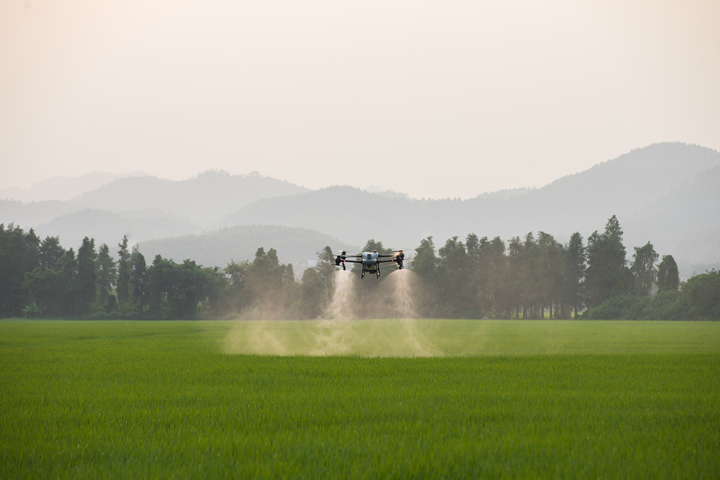The Role of Agricultural Drones in Modern Irish Farming

Agricultural drones have become a cornerstone of modern farming practices, offering a new level of precision and efficiency. In Ireland, where farming is both a tradition and a vital part of the economy, drones like the DJI T50 and DJI T25 are paving the way for more sustainable and effective farm management. This article explores the various applications of these drones, the challenges of using them within current EU regulations, and how they’re revolutionizing agricultural practices across the country.
Precision Agriculture and the Use of Drones
Precision agriculture, which involves the use of technology to monitor and manage farming operations, has gained momentum in recent years. Drones are a key tool in this approach, providing farmers with real-time data on their crops, soil, and land conditions. This data allows farmers to make informed decisions about irrigation, fertilization, and pest control, which can lead to improved yields and reduced waste.
In Ireland, where diverse terrain and climate conditions present unique challenges, drones can offer the flexibility and precision needed for tasks that would otherwise be labor-intensive and costly. Drones can cover large areas quickly, provide detailed aerial views of fields, and offer insights that traditional methods often overlook.
Applications of DJI T50 and T25 Drones in Irish Agriculture
- Greenhouse Shading Greenhouse management is crucial for farmers growing temperature-sensitive crops, and drones have simplified the process of applying shading materials. The DJI T50 and T25 can quickly and evenly distribute shading over large greenhouses, helping to regulate the internal environment and improve crop growth. This reduces the need for manual labor and ensures that the shading is applied consistently.
- Liquid Fertilization Drones equipped with advanced spraying systems can precisely apply liquid fertilizers, ensuring that nutrients are delivered exactly where needed. This technology helps farmers reduce waste, cut costs, and improve the health of their crops. The DJI T50 and T25 can be programmed to apply specific amounts of fertilizer across vast fields, making the process both efficient and cost-effective.
- Pest Control Drones are also used for applying biological pest control treatments, which can target specific areas of a field. This is particularly beneficial in Ireland, where hilly or uneven terrain can make it difficult for ground-based machines to reach certain areas. The drones ensure even distribution of treatments while reducing the risk of soil compaction.
- Aerial Seeding Aerial seeding is another area where drones excel, particularly in areas that are hard to access by traditional machinery. The DJI T50 and T25 can carry and distribute seeds over large areas quickly and efficiently. This technology is especially useful for farmers working on hilly terrain or managing large fields, where ground-based seeding can be labor-intensive and time-consuming.
Challenges: Herbicide Application and EU Regulations
While drones offer numerous benefits in Irish agriculture, they currently cannot be used for applying herbicides due to EU regulations. These rules are in place to prevent the potential spread of chemicals to unintended areas, which could harm nearby crops, water sources, or ecosystems. The European Union's strict approach to herbicide application is driven by environmental concerns and a commitment to promoting sustainable farming practices.
Despite this, many experts believe that drone technology could offer a more precise and controlled way to apply herbicides, reducing overall chemical use and environmental impact. As the technology continues to develop, there is hope that regulations will adapt to allow for the safe use of drones in herbicide applications.
The Future of Drones in Irish Agriculture
As drone technology becomes more advanced, its role in agriculture will likely continue to grow. Farmers in Ireland are increasingly recognizing the benefits of drones for precision agriculture, particularly for tasks like fertilization, seeding, and pest control. Although herbicide spraying is currently restricted, the future of drones in Irish agriculture looks promising.
With the increasing focus on sustainable farming and the need for efficient resource management, drones will likely play a significant role in the future of Irish farming. By providing real-time data and reducing the need for heavy machinery, drones like the DJI T50 and T25 offer a way for farmers to improve their productivity while reducing their environmental footprint.
Conclusion
The DJI T50 and T25 drones have transformed the way farmers in Ireland manage their crops and land. Despite current restrictions on herbicide spraying, these drones offer a wide range of applications, from greenhouse shading to pest control and aerial seeding. As regulations evolve and technology continues to advance, drones are set to become an even more integral part of Irish agriculture, helping farmers improve efficiency and sustainability.
For more information on how drones can help improve your farm’s efficiency, contact us to learn more about our services and training.
Neil McKeever is founder of Precision Drone Spray. With a strong background in both agriculture and technology, his passion lies in helping Irish farmers improve efficiency and sustainability using innovative drone technology. Through his work at Precision Drone Spray, he's focused on providing practical, drone-based solutions such as fertilization, pest control, and aerial seeding, all designed to meet the unique needs of Irish farmers.
The company specializes in utilizing cutting-edge drones like the DJI T50 and DJI T25, and is committed to showing how these technologies can transform farming practices in Ireland. By leveraging precision agriculture the mission is to support farmers in achieving better yields while reducing environmental impact.
For more information, visit: Precision Drone Spray.
Comments (0)
This post does not have any comments. Be the first to leave a comment below.
Featured Product

